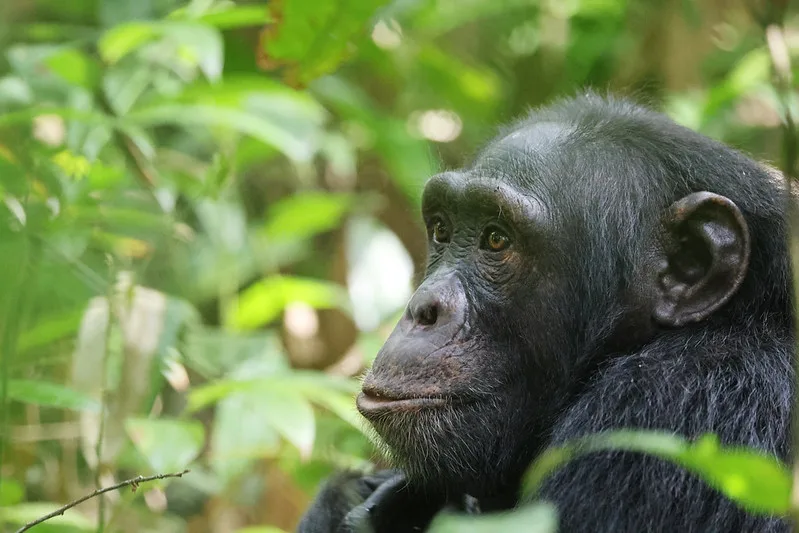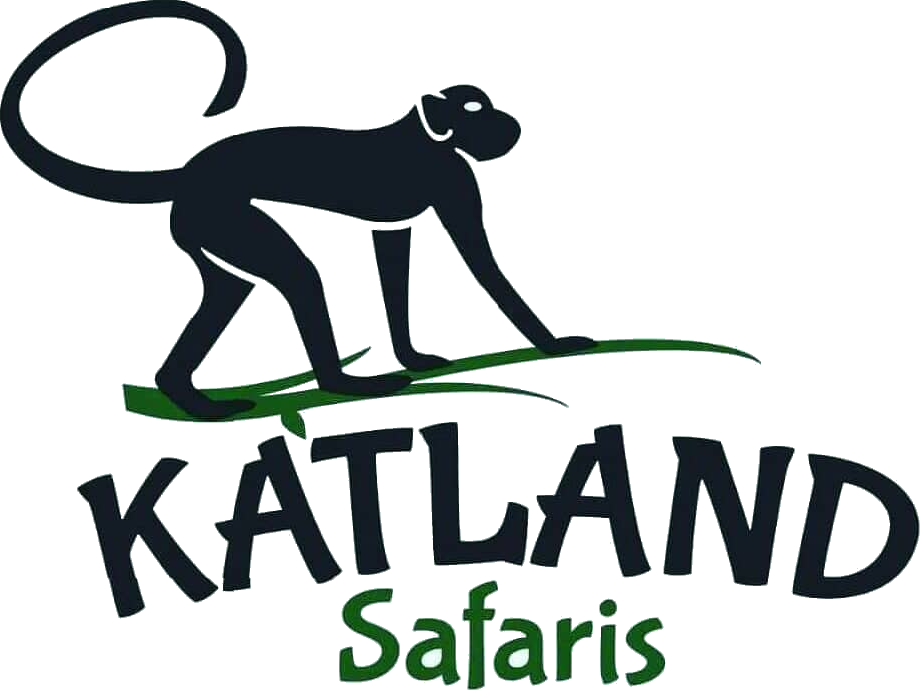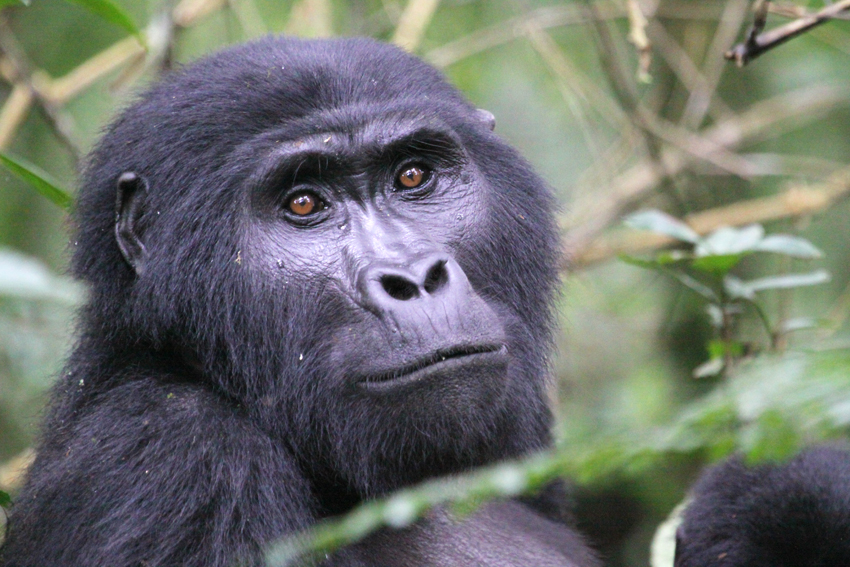How to book your chimpanzee permit in Uganda and Rwanda.
Chimpanzee permit in Uganda. Obtaining permission to go chimpanzee trekking in Uganda and Rwanda is required to participate in the activity. Currently, the price of chimpanzee trekking in Uganda is $300 per person. This price is applicable to the Kibale National Park situated in Uganda. Permits to hike with chimpanzees in Rwanda cost one hundred dollars per person, each expedition.
For both the morning and afternoon sessions, each party is only allowed to purchase a maximum of six chimpanzee trekking permits. This is done for conservation purposes because chimpanzees need a constant supply of food, and the trampled vegetation that is caused by mass tourism lowers the amount of food that they have access to.
Chimpanzee trekking permits are offered on a daily basis; however, there are two sessions that are planned, one in the morning and one in the afternoon. During chimpanzee trekking, we are only permitted to be in the presence of the chimpanzees for a maximum of one hour. This is done to allow the chimpanzeesto go about their daily routines.
Another chimpanzee activity that you may participate in is called chimpanzee habituation. This involves following semi-habituated chimpanzees in the wild in order to acquaint them with the presence of humans without causing any changes to their natural behavior.
From the moment the chimpanzees are removed from their nests, a group of researchers is permitted to be accompanied by a maximum of four individuals. Because the ranger guide and the researcher have a deeper understanding of the group that is being researched, you must continue to follow the directions that they have provided to you after the briefing.
How to Reserve Chimpanzee Permits in the Countries of Uganda and Rwanda | Chimpanzee permit in Uganda
Be aware of the day on which you would want to engage in chimpanzee trekking or habituation, as well as the number of individuals with whom you would like to participate in any of these activities. Because of this, you will be able to schedule the same amount of time for chimpanzee trekking or habituation with the folks you are traveling with, allowing you to create valuable memories together.
Following the receipt of your inquiry, our safari consultant will examine the availability of the chimpanzee permits in accordance with the current status of the permits. On the odd chance that it is good, we strongly advise our customers to get their chimpanzee trekking permits as soon as possible because they are the first ones to sell out. There is a first-come, first-served policy in place for them.
Following the completion of the payment process for your chimpanzee trekking or habituation permits, a receipt will be produced.
The Uganda Wildlife Authority and other conservation organizations, such as the Conservation Sanctuary and Wildlife Conservation Trust (CSWCT), which are responsible for the conservation of chimpanzees on behalf of the Uganda Wildlife Authority, are the entities that sell licenses to keep chimpanzees in Uganda under their protection.
It is the Rwanda Development Board that is responsible for selling permits to chimpanzees in Rwanda.
What are the best places in Uganda and Rwanda to go chimpanzee trekking?
Uganda is home to the Kibale National Park. | Chimpanzee permit in Uganda
The Kibale National Park is the most popular location in Uganda for chimpanzee trekking and habituation. A total of around 795 square kilometers of land is devoted to this park. The forest is home to around thirteen different kinds of primates, including chimpanzees.
Approximately one thousand five hundred chimpanzees are now residing in Kibale National Park. The blue monkey, the grey-checked mangabey, the vervet monkey, the black and white colobus, the red-tailed monkey, the L’Hoest’s monkey, the pottos monkey, and other primates are also included in this category.
Because the park’s southern park, which is next to Queen Elizabeth National Park, is shared with a migratory corridor that is 180 kilometers long. Queen Elizabeth National Park is home to a wide variety of animals, including huge forest pigs, elephants, waterbucks, bushbucks, duikers, and others. These animals move into Kibale Forest from Queen Elizabeth National Park.
Located inside Queen Elizabeth National Park is the Kyambura Gorge | Chimpanzee permit in Uganda
Despite the fact that it is located one hundred meters below the bottom of the rift valley, the Kyambura Gorge is one of the most distinctively wooded areas of the park. The river Kyambuta cut its way to the Kazinga channel, which it runs into, resulting in the formation of this canyon.
Kaniyo Pabidi Forest, located inside the national park of Murchison Falls
Some of the rare chimpanzees that can be found in Uganda can be found in this section of Murchison Falls National Park, which is loaded with mahogany trees. This sanctuary is home to a variety of primates, including but not limited to black and white colobus, vervet monkeys, grey-cheeked mangabey, blue mokets, olive baboons, L’Hoest’s, and others.
There are a variety of species that call this region of Murchison Falls National Park their home. Some of these birds include the chocolate-backed kingfisher, Puvel’s illaposis, olive green camaroptera camaroptera chloronata, red-necked falcon Falco chiquera, speckled mousebird Calius striatus, and more.
The sanctuary for chimpanzees on Ngamba Island | Chimpanzee permit in Uganda
This facility provides a home for several chimpanzees who have been orphaned, rescued, or abandoned and are unable to return to their groups. From the guest platform, you will have the opportunity to participate in feeding these chimpanzees. Your presence here is not only enjoyable, but it also helps to improve the lives of these chimpanzees, contributes to the conservation effort for chimpanzees, and assists the community in which you live.
UWEC stands for the Uganda Wildlife Education Center.
This location was once known as the Entebbe Zoo; however, the animals here are no longer kept in cages; rather, they are shown in a manner that is analogous to the natural setting in which they are found.
Chimpanzees are one of the species that are housed at this facility, along with other animals. Whether you choose to go on a guided tour or a self-directed trip around the center, you will have the opportunity to take in the view of the chimpanzees from their space. As a result of the many fascinating activities that they do, your attention is constantly drawn to them.
The Rwandan national park, known as Nyungwe | Chimpanzee permit in Uganda
It is the only refuge in Rwanda that is dedicated to chimpanzees. Other primates, such as black and white colobus, vervet monkeys, grey-cheeked mangabey, red-tailed monkeys, olive baboons, and vervet monkeys, may be found in this park.
This location is one of the most well-known birding hotspots in Rwanda, and it is home to around 283 different species of birds, 29 of which are indigenous to the Albertine Rift. Among the Rwandan birds that you may be able to recognize are the Archer’s Robin-Chat, Sunbirds, Red Collared Mountain Babbler, Kivu Ground Thrush, Dusky Crimsonwing, Blue Flycatcher, and a few more.
When is the most favorable time to make reservations for chimpanzee trekking safaris?
When the chimpanzees are active, the months of June through September and December through January are the most exciting times to go chimpanzee trekking in Uganda and Rwanda. This is because the woodlands get fewer drops of rain during these months.
Because they are afraid of being in areas that are saturated with water, chimpanzees have a tendency to hide among the branches of trees during periods of intense rainfall. If you want to obtain a better glimpse of chimpanzees that are up in the trees during the rainy seasons, you will need to bring a pair of binoculars with you.
When it comes to chimpanzee trekking in the forest, the rainy seasons, which are March through May and November, see a decrease in the number of tourists. People who are interested in shooting or photographing animals with less interruption from other trekkers may take advantage of this chance to record wonderful moments with the chimpanzees via the usage of this opportunity.
The chimpanzees spend their day seeking food that will sustain them throughout the day and night. They also lounge about at some time in order to take a sleep or groom the young.
In Uganda and Rwanda, how challenging is it to go on a trek with chimpanzees? | Chimpanzee permit in Uganda
As a result of the relatively flat landscape of the chimpanzee trekking zones, there are fewer opportunities to go on hikes and find the chimpanzees. One of the reasons why a youngster who is 15 years old or younger may be permitted to go on a journey with the chimpanzees is because of this. Another benefit of the forest is that it has less undergrowth, which makes it easier for hikers to go through the pathways.
Because mountain gorillas are very intelligent primates, you must adhere to the chimpanzee habituation standards that have been established by the relevant agencies to fully appreciate the whole experience. They are aware of anyone who could be intruding on their place.
What Kind of Risks Are Involved When Spending Time in Uganda and Rwanda?
It is of the utmost importance to ensure the safety of chimpanzees, visitors, and people in the vicinity of the parks. In order to maintain peace and order in both Uganda and Rwanda, the rangers collaborate closely with the representatives of the local authorities as well as other security agencies.
During your chimpanzee trip, you need to bear in mind the need for personal protection.
Maintain a closer proximity to the group of hikers that you have been specifically assigned to travel with. In the woods, you will not get disoriented. Given the size of these woods, you must maintain a proximity to the rangers who are guiding you through them.
If you are at risk of getting food poisoning, you should avoid eating from dangerous locations. If you get infected with a contagious disease, like as diarrhea, you can be excluded from participating in chimpanzee trekking or Habituation.
Under no circumstances should you go into the forest without the company of an escorting ranger. This is because you need protection from other forest inhabitants who are not used to the presence of humans.
If you are carrying valuable objects that you are unable to completely guard, you are putting yourself at risk since you do not know who could be watching you or following you in order to take them.
When bigger quantities of money are counted in public, it may draw the attention of criminals.
On safari, you should just bring a few bags that contain the essential stuff you will need so that you do not end up losing any of them.
For the purpose of preventing your chimpanzee hiking or habituation supplies from being dispersed in the wild, you should pack them in a single lightweight and waterproof backpack.
So that you do not end up getting lost on the route to go chimpanzee trekking, it is recommended that you hire a competent driving guide. It is comforting and reassuring to have a driver who is informed, even after you have completed your excursion.
Refrain from providing any information on your credit card to anybody about whom you are uncertain, since this information might potentially fall into the wrong hands.
What You Should Bring with You When Going Chimpanzee Trekking in Rwanda and Uganda | Chimpanzee permit in Uganda
When you are out in the outdoors, you should wear sunglasses to protect your eyes from bugs buzzing.
A camera that allows one to snap photographs of the events that take place in the outdoors and create memories of every incident. In the event that it rains in the forest, prevent yourself from getting wet by wearing rain gear.
You should bring a foldable water bottle with you so that you may drink water in the event that you get thirsty while you are acclimating the chimpanzees.
To get a better look at the chimpanzees and other animals that live in the forest, you should use binoculars.
Use sunscreen to protect your skin from the harmful effects of the sun, particularly during the dry seasons.
Not open. You should wear safari shoes so that your feet are protected from any sharp bits of wood that you could come across on your journey.
What to eat if you get hungry when you are out in the woods.
In order to prevent rainfall from dripping off the trees and damaging your hair, you should wear a safari hat with a wide brim. It must be able to be folded.
On the evenings spent in the bush or on the edges of Nyungwe National Park or Kibale National Park, pyjamas are the appropriate attire.
An insect repellent that will keep away potentially dangerous insects that fly in the outdoors
In the event that you need to make a purchase, you should have some hard cash on hand to convert into the local currency. It is difficult to use credit cards in Africa due to the slow process of recovering money from them.
You should bring toiletries like as soap, bath foam, and toilet paper with you in case your lodge does not supply them or if they are not suitable for your skin.
Long-sleeved shirt with a turn-up collar and convertible pants in hues that are suitable for usage in the outdoors, such as khaki or tan.
In the event of an emergency, prepare a first aid kit for use.
Rules for Trekking with Chimpanzees | Chimpanzee permit in Uganda
At any point during chimpanzee trekking or habituation, flash photography is strictly prohibited since it has the potential to induce the chimpanzees to go into hiding. They have a phobia of new happenings that are closer to them. If it is forecast to rain, the folks are often used to the lightning.
It is forbidden to consume food or smoke at a distance of three hundred meters from the gorillas because you do not know how the smoke will affect the chimpanzees. Therefore, this is done in order to lessen the likelihood of transmitting an illness to the chimpanzees. Chimpanzees have around 98% of their DNA derived from humans, which brings them quite near to becoming human relatives within the animal world.
Volunteer to remain behind in the event that you get ill with a contagious illness such as the flu, a cough, or the coronavirus. This will ensure that you do not transfer only to these gentle giants. It is quite likely that they will succumb to human illnesses, which might result in their deaths in large numbers.
It is against the law to spread rubbish across the forest, particularly debris that cannot be broken down, such as plastic wraps. The natural environment of the forest, which is where chimpanzees eat, is altered as a result. Chimpanzees prefer to eat the leaves, fruits, and plants that are already present in their natural environment rather than relying on the food that is given by humans.
If you want the gorillas to feel as if they are being attacked, you should avoid encircling them and instead stay close to your chimpanzee trekking or habituation crew. When encircled, they have feelings of being overwhelmed and may begin hooting in the event that they detect anything that seems suspicious.
When you find chimpanzees, you are only permitted to go on the chimpanzee trekking for a maximum of one hour. For them to continue with their day-to-day behaviors, like as eating, grooming, and other activities, they have been trained to be in the company of people for this amount of time.
When you find the chimpanzees, maintain a distance of around 8 meters from them. In order to lessen the likelihood of transmitting any kind of illness to the chimpanzees, this measure has been taken.
Avoid spitting on the plants since it is a source of nutrition for the chimpanzees. They consume it throughout the day in order to keep their bodies functioning properly throughout the day and night. Ants are a possible addition to their diet, and during the most severe dry seasons, they may even consume monkeys, although this is quite uncommon.
It is very prohibited to provoke the chimpanzees because they have the potential to get so enraged that they would start a stampede in the forest with their hooting.


